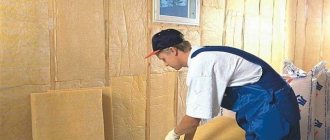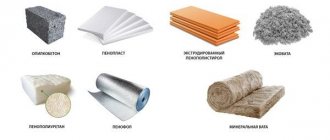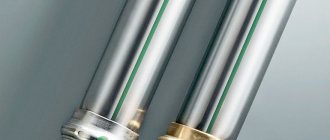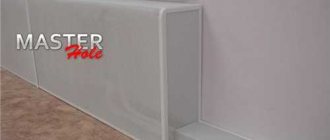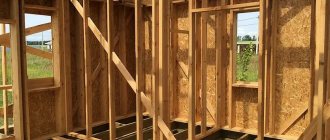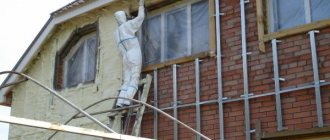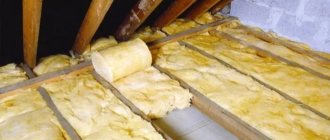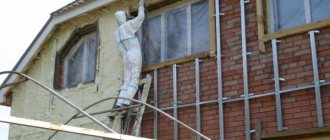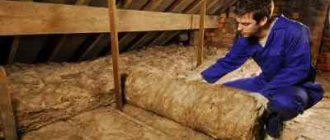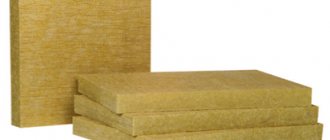Considering the level of real estate prices and its continuous growth, the construction of a frame house looks like a completely budgetary and realistic undertaking. In addition, anyone, even if they have not held anything heavier than a mouse in their hands, can do some of the work themselves. However, when building a house, you need to study many issues, including how to more effectively insulate it. In this article, the editors of Yanashl have prepared a review of the best insulation materials for 2022.
Rating of insulation for frame houses
When compiling the review, products from brands with a good reputation were considered. Technical characteristics, structure, ease of installation, and availability of certificates were studied. Feedback from property owners, opinions of builders and heating engineers were taken into account. The main attention was paid to the following parameters:
- Composition – they produce insulation based on mineral wool, basalt wool, polystyrene foam;
- Thickness – a wide range of sizes is welcome;
- Thermal conductivity - the lower the coefficient, the less insulator needed;
- Water absorption – should have minimum values;
- Fire safety is an advantage of non-combustible materials.
Uneven density, mechanical defects, the ability to support combustion and absorb a large volume of water - insulators with such defects were excluded from our rating.
Video description
We will dwell in more detail on insulating a house with polystyrene foam. Find out how safe polystyrene foam is in our video:
Expanded polystyrene (penoplex)
Expanded polystyrene is a popular thermal insulation material due to its long service life, low cost and excellent sound and heat-saving properties. The material demonstrates high hydrophobicity (absorption volume is no more than 3% of weight), compressive and bending strength, fire resistance and non-toxicity.
Penoplex boards are attached to the frame posts with glue. Experts advise protecting the material from solar ultraviolet radiation.
Expanded clay
The material is the most common and proven fill-type insulation; It is used in thermal insulation of floors, floors and walls. Expanded clay is based on refractory clays, which are subjected to heat treatment during the production process. The result is granules, crushed stone or sand with a characteristic porous structure and attractive parameters, which include good thermal insulation and low weight, environmental friendliness, chemical inertness and vapor permeability.
Various fractions of expanded clay Source stroyfora.ru
Expanded clay is not flammable and does not lose its thermal insulation properties when temperature fluctuates. The only drawback of expanded clay is that its heat-protective properties are inferior to synthetic materials.
Foam glass
Not only expanded clay is produced in the form of granules, but also foam glass - a material with a higher level of thermal protection. Sand and broken glass are used to make it, which automatically turns the material into the safest and cleanest product. Granulated foam glass is indifferent to bio- and chemical agents, moisture-resistant, and its only (and tangible) disadvantage can be considered its high cost.
The best mineral wool for insulating a frame house
For property owners and builders, insulating a frame house with mineral wool means reducing costs with a good quality final result. The material is made from fibers obtained from the melting of glass, rocks, and blast furnace slag. The insulation has a different structure, can withstand heating up to 600-700 degrees, and has a low thermal conductivity coefficient. Used for walls, floors, ceilings and partitions.
Heat Knauf Cottage – Thermo Plate 037
Produced by a German holding, supplied in slabs measuring 50x610x1230 mm. The fibers are made from rocks and are additionally impregnated with Aquastatik, which provides water-repellent properties. It is an environmentally friendly insulator and does not emit phenol, formaldehyde or acrylic resins into the air.
The finished insulation at the enterprise goes through a compression stage, this allows reducing transportation costs by 5-7 times compared to uncompressed heat insulators. The plate is elastic, does not break when bent, and quickly and easily restores its geometry. Can be used to insulate walls, pitched structures, and floors. This is a non-shrinking insulator that retains its structure in the frame for 50 years.
Advantages:
- Easy to cut;
- Resistant to biological effects;
- Not subject to combustion;
- Minimum water absorption;
- Low price;
- Convenient installation.
Flaws:
- Not detected.
The ECOSE technology is used in production: a composition obtained from natural organic substances is used as a binder. For this reason, the fibers have a characteristic brown tint, indicating that phenol-formaldehyde resins are not used in production.
Isoroc Super Warm
It is produced at a Russian plant, which belongs to the largest manufacturer of building materials in the world. It has a low thermal insulation coefficient and, according to this criterion, is 15-20% superior to competitors in its class. Specially designed for prefabricated buildings, intended for floors, walls, pitched roofs. It is characterized by increased strength and good elasticity, which allows installation without fasteners.
Retains its shape for 50 years after installation, the absence of shrinkage allows you to avoid the appearance of cold bridges and save on heating in winter. Hermetic packaging with sealed ends simplifies storage and effectively protects against moisture absorption. The fibers are additionally treated with water-repellent compounds. Moisture resistance indicators are 10-12 times higher than GOST requirements.
Advantages:
- Does not crumble or break during installation;
- Convenient for transportation format;
- Improved dimensional stability;
- Made from environmentally friendly raw materials.
Flaws:
- Generates dust during operation.
Euroizol ECO 30
Low-cost thermal insulation for vertical and horizontal non-load-bearing structures. The fiber is obtained from molten rocks, which makes the building material non-flammable and able to withstand temperatures of 700-800 degrees. A heat insulator has been developed for civil engineering, the content of organic substances does not exceed 4%. Does not release harmful substances into the air.
Supplied in slabs that are convenient to install in the sheathing. The thermal conductivity coefficient is 0.036-0.042 W/m*K - not the highest in the class, but consistent with current SNiPs. The material can be used to insulate houses where you plan to live in the winter. Packaged in durable polyethylene film, compression up to 20% is allowed.
Advantages:
- Good sound insulation properties;
- No phenol-formaldehyde resins are used in production;
- Light weight;
- Doesn't crumble.
Flaws:
- Under load it loses its shape.
The best manufacturers of plastic windows
What materials are used for wall insulation?
Today there is a huge range of insulation products on sale. If you are building a frame house made of wood, it is important for you to know about the vapor permeability coefficient (VP) of the insulation. This indicator will help you choose the most suitable material for you from the whole variety. The main criterion here is to choose an insulation whose vapor permeability is not lower than the wood used for the frame.
For the construction of frame houses in our country, softwood is mainly used, and its CP can be found in the table below:
| Material | KP |
| mg/(m h Pa) | |
| Extruded polystyrene foam | 0.013 |
| Polyurethane foam | 0.05 |
| Styrofoam | 0.23 |
| Expanded clay | 0.21 |
| Pine and spruce across the grain. | 0.32 |
| Ecowool | 0.32 |
| Mineral wool density 200 | 0.49 |
| Mineral wool density 50 | 0.6 |
| Reinforced concrete with a density of 2500 kg/m3. | 0.03 |
The table shows that it is better not to use some materials for insulation at all; their CP is much lower than wood, and the most suitable for this are mineral wool and ecowool.
Various compositions are used to produce mineral wool. Depending on the type of composition, its types are distinguished:
- Stone or basalt - created mainly from rocks. This type is distinguished by durability (does not lose its properties for more than 50 years), heat resistance (withstands heating of more than 1000 degrees). The insulation practically does not shrink and does not lose its geometric dimensions during the entire service period, and accordingly, cold bridges will not form in the walls. Another advantage of this cotton wool is its hydrophobicity. Water-repellent properties appear thanks to special additives. They do not allow moisture to penetrate inside the insulation and do not accumulate condensation. This insulation is produced in the form of slabs, which is very convenient for frame construction. The optimal density is considered to be 35 – 50 kg/m. Also, do not forget that when laying the slab should be 3-4 cm wider than the frame, this will avoid unnecessary gaps.
- Glass - created on the basis of fiberglass. Its properties are similar to stone, but it is made from the same materials that are used in glass production. The release form also differs; it is produced mainly in the form of rolls of different sizes. This material is often opposed by the fact that during installation it produces a lot of glass dust and it is necessary to work with it only in a respirator. This also repels potential buyers. However, in practice, if installed correctly and all certification conditions are met, glass wool is absolutely safe and does not pose a health risk. Due to its lightness and springy fibers, the material holds well in the frame. For denser installation, the material is cut into strips 15-20 cm wider.
- Slag insulation is now quite rarely found on a construction site. This is a cheap but short-lived material. Formed during the processing of blast furnace waste. Fragile, brittle and not environmentally friendly, a possible area of application is filling the foundations of courtyard buildings and sewers.
- Ecowool is the most modern of the materials presented. It is produced on the basis of cellulose with special additives that protect it from rotting and parasites. Superior to mineral wool in sound absorption (more than 2 times). Resistant to high temperatures, does not emit toxic substances when ignited. Recently, it has been increasingly used for insulation of residential and non-residential premises. The material does not get wet and prevents condensation. However, there are also disadvantages. The first and main one is that today it is one of the most expensive insulation materials, and also requires additional equipment during installation.
It is worth mentioning that there are three options for installing ecowool:
- Dry – using special equipment, dry material is blown into prepared areas using air, these can be attics, interfloor ceilings, as well as the internal surfaces of roofs and floors.
- Wet – material mixed with water is sprayed onto the walls. When dry, a dense layer is obtained, which can be sewn up with finishing and decorative elements. At the same time, the cotton wool does not shrink in any way and does not generate dust during installation.
- Adhesive - used when you need to insulate the inner surface of a metal or reinforced concrete wall. The glue increases adhesion, and due to the fact that a fairly dense composition is obtained, it does not require additional covering.
The best stone wool for insulating a frame house
Stone wool often tops the ratings of insulation for frame houses due to its resistance to high temperatures. The fibers are obtained by melting rock basalt. Plates and rolls can easily withstand heating up to 1000-1100 degrees. This allows them to be used for thermal protection of load-bearing structures.
Rockwool Light Butts Extra
Thermal insulation is regularly included in the TOP of the best multifunctional solutions. Using this insulator you can insulate external walls, interfloor ceilings and floors. This is a non-flammable material with a low thermal conductivity coefficient. A distinctive feature is high strength, resistance to static and wind loads. For vertical installation, installation heights of up to six meters are allowed without reinforcing jumpers.
It is well fixed between the rafters of the pitched roof - it does not sag or shrink. Provides air exchange and does not release substances hazardous to health into the air. Made using Flexi technology: one edge is elastic, which simplifies installation between load-bearing structures. The insulation is springy and rests against the frame beams.
Advantages:
- High efficiency in three-layer systems;
- Service life of at least 50 years;
- Increased pace of installation work;
- Minimal hygroscopicity.
Flaws:
- Not detected.
Izovol Izobel
The 10 cm thick slabs are produced using Ecosafe technology from basalt rocks without the use of blast furnace slag or coke. The fibers can withstand heating up to 1100 degrees without losing their shape or strength. The building material has good breathability, which allows you to effectively remove excess moisture, creating comfortable indoor conditions and extending the service life.
The insulating fiber is resistant to aggressive substances - acids, alkalis, and does not attract the attention of rodents. Basalt fibers do not create an environment attractive to fungus or microorganisms. The slabs are elastic, do not crumble during installation, and are easy to cut with a knife. The linear coefficient of expansion is zero, which guarantees no shrinkage.
Advantages:
- Used outside and inside the building;
- Improved sound insulation characteristics;
- Good hydrophobicity indicators;
- First group of fire retardant efficiency.
Flaws:
- Be sure to use a vapor barrier.
TechnoNIKOL Rocklight
In the production of insulators, basalt fiber and a low-phenolic binder are used. Its low density makes insulation the best material for the construction of attics, non-load-bearing structures, and floors above the ground floor.
The thermal insulation is dense, cuts well with a knife, and trimming is done without crumbs. Density and elasticity allow installation alone. The geometry of the slabs is strictly maintained, vapor permeability meets the requirements of GOST. The structure provides good protection against street noise. The thickness of 5 cm makes it convenient for creating multi-layer structures. Packed in a thick film that protects from moisture and is difficult to tear during transportation.
Advantages:
- No shrinkage;
- Service life more than 50 years;
- Low price;
- Minimum load on supporting structures.
Flaws:
- Not suitable for insulating external walls.
What you need to know
The insulation material should be chosen before construction begins. Selection errors, like savings, can be very costly. For a frame house, this is, in fact, the only barrier from the cold.
It is worth noting that more than half of such houses in our country are insulated with mineral wool or other materials based on it. Therefore, in our review we will mainly consider such insulation materials.
Mineral wool, first of all, is a convenient material, it is easy to transport, convenient to supply to a construction site and store, not to mention installation. It bends and cuts with any knife. In addition, it is a fairly environmentally friendly, lightweight and resistant to rotting and pests material.
The best polystyrene foam for insulating a frame house
When constructing frames, extruded polystyrene foam is used. The material has a closed structure, does not absorb water, and has high strength characteristics. The slabs can be laid on the ground and used in “wet façade” systems. Extruded polystyrene foam has a high density, it cuts well, does not crumble, and does not break during transportation.
Penoplex Comfort
Supplied in slabs measuring 118.5x58.5cm 50mm, which are produced by extrusion. It has zero water absorption and is one of the best insulation materials for the outside of load-bearing structures. Withstands high pressure, can be laid along rafters or used in the construction of flat roofs. Low thermal conductivity makes it possible to reduce the thickness of the insulator used.
The slabs have a ledge along the edge, which ensures the absence of cold bridges and simpler and more reliable installation. The building material is biostable, cultures of fungi and microorganisms do not develop in it, and it does not attract the attention of rodents or birds. Freons and other harmful substances are not used in production. Comes with a protective film that provides resistance to solar ultraviolet rays.
Advantages:
- Duration of service more than 50 years;
- Frost resistance;
- No emission of organic substances;
- Does not lose thermal characteristics under pressure.
Flaws:
- Low vapor permeability.
Technoplex
Russian extruded polystyrene foam is made using nanographite, which improves thermal parameters and increases strength. Supplied in transport bags made of polymer shrink film, which protects against exposure to ultraviolet rays. It is characterized by low water absorption, good frost resistance, and does not collapse during operation.
Supplied in slabs 118x58cm, 30mm thick. Low thermal conductivity allows you to reduce the amount of building material used for insulation. Can be used when arranging floors on the ground, laying on rafters. It has high compressive strength and belongs to group G4 in terms of its flammability. Retains its characteristics during temperature changes.
Advantages:
- Does not require replacement after 50 years of service;
- Does not emit harmful substances when heated;
- Saves usable space when insulating from the inside;
- Easy installation.
Flaws:
- Low vapor permeability.
Wind and steam protection
No matter how hard insulation manufacturers try to endow their products with hydrophobic properties, no one will be able to get away from condensation, temperature changes, weather phenomena and other sources of dampness. To minimize the negative impact of dampness on heat-saving material, vapor barrier and wind protection are used.
Vapor barrier is used to protect against moisture and vapors coming from inside. The effectiveness of the entire insulation largely depends on the quality and correct installation of this shelter.
External protection is also important. Although it does not look impressive in appearance, all these materials together give the desired result.
The final choice of insulation will remain with the owner of the house, and in order not to be disappointed in the result obtained, it is worth studying all the main characteristics of the best insulation materials on the market. The right material will make your home warm and energy efficient.
The best glass wool for insulating a frame house
The production uses the same raw materials that are used in glass production. Many companies use waste glass to obtain a melt from which they form filaments. This helps reduce production costs. Glass wool fibers are longer than those of basalt thermal insulation, which can cause breakage and slight changes in structure.
Isover Warm House-Stove
Form-stable slabs 1170x610x50 mm are designed for installation between rafters and load-bearing frame elements. A distinctive feature is increased elasticity, which ensures a tight fit and the absence of cold bridges. This allows one person to work, performing insulation at a high professional level.
The material belongs to the NG group, is safe for health, and does not emit volatile organic substances into the environment. Thermal conductivity is one of the best in its category, allowing you to reduce heating costs when permanently living in a cottage. Supplied in a thick film that protects from high humidity and UV radiation.
Advantages:
- Does not generate dust;
- Does not break during installation;
- Low price;
- Good level of sound insulation;
- Vapor permeability.
Flaws:
- Can absorb moisture.
Ursa Terra 34 PN Pro
The products of a European brand with 70 years of experience are environmentally friendly and safe for health. Produced automatically with control of 20 parameters and binder consumption. They are produced in the form of slabs 1000x610x50 mm, which protect well from heat loss and external noise. Terra's proprietary polymer substance is used to bind the fiber.
The material has good elasticity, which simplifies installation work in the frame or in the space between the rafters. Refers to non-flammable substances, the fiber structure is reinforced, which reduces the level of dust. Thermal insulation is biostable and does not decompose under the influence of aggressive substances.
Advantages:
- Low water absorption;
- Good vapor permeability;
- High thermal conductivity;
- Retains properties at temperatures up to 220 degrees.
Flaws:
- Not detected.
Video description
Galileo. Stone wool:
Glass wool requires careful handling Source pinterest.fr
- Slag wool . The raw material is molten blast furnace slag. This type of filler is similar in properties to glass wool; It is recommended to use it only for dry rooms. The main advantage of slag wool is its low cost.
Walls, ceilings and roofs are insulated with cotton wool; The thickness of the layer in a country house for year-round use should be 200-250 mm. The peculiarity of cotton wool is that its hygroscopicity is neutralized by the use of vapor and waterproofing membranes. The density and thickness of the material affects not only the cost, weight and load resistance, but also the way it is used:
- Rolled fabric (often laminated, with foil coating). Effective heat retaining material. Used for thermal insulation of horizontal surfaces, has a density of 35 kg/m3.
- Plates . Material with a density of 75 kg/m3 is used to insulate the floor, ceiling and interior partitions, and a density of 125 kg/m3 is used to insulate the facade. More rigid slabs (200 kg/m3) are used for interfloor ceilings, roofing and screed floors.
Element of the roofing pie - mineral wool with foil coating Source pinterest.cl
Ecowool
Cellulose wool (known to the general public as ecowool) is an example of an environmentally friendly product. It consists of 80% of newspaper waste paper and waste from the cardboard and paper industry, and 20% of additives that perform a flame-extinguishing function (boric acid and sodium tetraborate). In appearance it is a loose material of various shades of gray.
Ecowool has proven itself well as sound and heat insulation; it insulates all parts of the frame structure. The disadvantages of ecowool are its high cost and the use of special equipment during installation. Insulation of a frame structure with ecowool is carried out in one of four ways:
- Dry backfill . Manual labor-intensive method, limited in application. Suitable for insulation and soundproofing of small-area interfloor ceilings, ground floor floors, and attic floors.
- Dry blowing . The most preferred (fast and high-quality) method, suitable for insulating any cavities. It is carried out using blow molding equipment.
How to choose insulation for a frame house
Owners of budget real estate will always be faced with the question: how to insulate a frame house for winter living? The insulator must meet the requirements of current SNiPs and GOSTs for fire safety and provide the required level of thermal conductivity. To do this, when choosing, pay attention to the thickness of the thermal insulation, its type, and water absorption coefficient.
Type of insulation
The following types of materials are produced:
- Mineral wool is a good balance between price and thermal performance. Rigidity allows it to be used for any mansion structure;
- Stone wool - fibers can withstand the highest temperatures. It has increased strength and can be used in wet façade systems. Disadvantage: overpriced;
- Glass wool is the cheapest insulation material, formed from brittle fibers. Recommended for structures that do not experience constant loads;
- Extruded polystyrene foam is a strong, durable, non-flammable material that does not absorb water. Disadvantage: low vapor permeability. It is recommended to buy insulation for a frame house only if there is a good ventilation system or for insulating the floor or basement.
All types of thermal insulation can be used during work, but the scope of application must take into account the characteristics of the materials.
Thickness
The thermal characteristics of structures depend on this indicator. For central Russia, at least 150-200 mm of thermal insulation with a low thermal conductivity coefficient is required to ensure the required level of comfort. Manufacturers produce slabs with thicknesses from 20 to 200 mm. The most convenient to use are 50-100 mm insulators, which are used in two-layer and three-layer structures, which reduce the risk of cold bridges.
Thermal conductivity
The lower the thermal conductivity coefficient, the less thermal insulation is required. The most effective are stone wool, mineral wool and extruded polystyrene foam. Glass wool has a higher coefficient, so it requires 15-20% more. This increases transportation costs and reduces the usable area of the building. Thermal conductivity is the main indicator necessary for calculations by heating engineers when determining the thickness of thermal insulation.
Water absorption
The role of an insulator in any insulation is the air that is between the fibers or in the spheres of polystyrene foam. If a material absorbs water, its thermal conductivity increases sharply. It gets cold in the cottage, the walls and ceilings begin to freeze. It is recommended to use insulators with a water absorption of no more than 1%, and to protect them from moisture, use a vapor barrier film.
Fire safety
The main material of frame construction is wood. To protect this material from fire, fire retardant impregnations are used, but the bulk of the walls and ceilings is thermal insulation. It must be fireproof. Stone, mineral wool, extruded polystyrene foam have the appropriate parameters. Glass wool is a non-flammable material, but cannot withstand high temperatures. Regular polystyrene foam can support combustion and is not recommended for use in construction.
Calculation
The main task of the calculation is to determine the thickness of the insulating layer to achieve the required thermal resistance of the structure. The minimum thermal resistance (R) is 3.5 sq.mhdeg/W. It consists of R1 of the element itself (wall, ceiling, etc.) and Rу of the insulating layer.
The basic formula for calculating R=b/k, where b is the layer thickness (m), k is the thermal conductivity coefficient (W/mhdeg).
Calculation procedure:
- Determination of R1 using the given formula. For example, k of brickwork is 0.56 W/mhdeg. With a wall thickness of 0.38 m (1.5 bricks) R1 = 0.38/0.56 = 0.68 sq. mhdeg/W.
- Determination of the missing thermal resistance as R-R1. In our example, it is 3.5-0.68 = 2.82 sq. mhdeg/W.
- Determining the thickness of the required insulation. It is calculated in the form b=Ryxky, where ky is the thermal conductivity coefficient of the insulation. If you use mineral wool with ky = 0.045 W/mhdeg, then the thickness will be determined as b = 2.82 × 0.045 = 0.127 m.
To determine the need for the amount of insulation, it is necessary to multiply the thickness by the area of the structure and take into account the reserve for waste (10-12%).
What is the best insulation for a frame house?
Professional builders and heating engineers know which insulation is best to use for the walls of a frame house, and which should be chosen only for floors or pitched roofs. A correctly made decision allows you to increase the service life of structures. The VyborExperta.ru team recommends purchasing the following insulators, taking into account the scope of application:
- Heat Knauf Cottage Thermo Plate 037 – for small country cottages;
- Isoroc SuperWarm - for insulating walls and pitched roofs;
- Rockwool Light Butts Extra - the choice of the owner of a large mansion;
- Penoplex Comfort - for floor insulation on the ground;
- Isover Warm House-Slab - for budget construction.
All materials presented in the review are worthy of attention, but only the most convenient and warm insulators received the title of best thermal insulation in their class.
Insulation materials: types and characteristics
Before choosing insulation for a frame house, you should familiarize yourself with its varieties. Materials used in construction are usually classified according to method of application:
- Backfill . Backfill method - insulation using ecowool, expanded clay, foam glass or sawdust.
- Sprayable . “Wet” technology is suitable for ecowool and polyurethane foam.
- Slab (roll) . The thermal insulation layer is fixed between the posts or in the ceilings of the frame structure.
Proper floor insulation in a frame house is the key to comfort Source strojdvor.ru
Insulation materials are also divided into two large groups based on their origin:
- Natural . This includes materials of natural origin that have long been used in construction: moss, sawdust, peat, straw. They are available, cheap and environmentally friendly. The main disadvantages of natural insulators are flammability and high hygroscopicity, leading to the appearance of mold fungi. Do not discount insects and rodents, who also highly value naturalness and environmental friendliness.
- Synthetic . Materials that have emerged through progress and human ingenuity. They are often non-flammable, easy to transport and use, and biologically stable. And, although synthetics are not without their drawbacks (they are more expensive, and when burned they release dangerous toxic compounds), they are valued in construction for their convenience and valuable properties.
Synthetic insulation for frame walls is conventionally divided into soft and hard. The soft insulation is covered with sheathing on both sides; then you can install vapor and waterproofing, then decorative cladding.
Floor insulation scheme with synthetic material Source patter.ru
Common mistakes
To ensure that in a year or two, due to freezing of the walls, you do not have to remove the finishing and replace the insulation with protective films, you must strictly follow the construction technology.
The most common mistakes leading to costly repairs:
- Using mineral wool of unsuitable thickness or density. The insulation shrinks very quickly and cracks form. Laying rolled materials in vertical structures is not allowed.
- Installation of insulator with strong force. Compression leads to a decrease in heat-shielding properties; an allowance of 10-20 in width is sufficient.
- Laying slabs without overlapping seams. The formation of through gaps at the joints is inevitable, leading to heat leaks.
- Incorrect installation of steam and waterproofing materials. On the packaging or in the instructions, the manufacturer indicates which side of the membrane should face the room. If the packaging is damaged, you should check with the seller.
- Leaky vapor barrier circuit. Due to non-compliance with technology, punctures or breaks during installation, gaps may arise through which steam will enter the insulation. Subsequently, these areas turn into cold bridges or sources of mold.
- The lack of connection between the vapor barrier and the floor leads to dampening of the insulation in the lower part of the walls. The film should be folded over and pressed down from above with a tie.
- No ventilation gap. Water is the scourge of building structures, especially wooden ones. The clearance between the sheathing and the insulation must be at least 40 mm.
The best insulation manufacturers
Having chosen the type of insulator, all that remains is to find the manufacturer. According to customer reviews, identical materials from different suppliers differ greatly in composition and properties. Among the trusted brands that manufacture thermal insulation products are:
- ROCWOOL is the undisputed leader in the production of basalt materials with an average price of 455 rubles.
- Knauf - supplies high-quality expanded polystyrene foam for sale with a price tag starting from 866 rubles.
- Isover is a supplier of mineral wool at a price of 650 rubles. per stove.
- Ursa - develops glass wool materials that cost about 528 rubles.
The listed companies value their reputation and are included in the rating of the best suppliers of insulation, therefore they sell only reliable and durable products with good insulation characteristics.
Thermal insulation with mineral wool: step-by-step instructions
In most cases, mineral wool in the form of mats . Therefore, subsequent instructions will be based on working with this material.
Preparatory activities
The first thing you need to do is understand the structure of the insulation cake, calculate the material and prepare the surface for installation. It doesn’t matter which side to start the work from - outside or inside. Some people believe that it is more convenient to perform thermal insulation from the street side. However, weather factors must be taken into account.
The standard structure of a thermal insulation cake with the order of layers from the internal cladding to the facade of the house:
- Decorative finishing indoors.
- OSB board.
- Vapor barrier.
- Insulation layer.
- Windproof membrane.
- Lathing made of bars for arranging a ventilation gap.
- OSB board.
- External cladding.
The recommended pitch of frame beams is 580-590 mm. This range is optimal when using standard mineral wool mats 60 cm wide. According to the standards, the thickness of the insulation for temperate climates is 150 mm. To fill the space between the beams of 15 cm, it is advisable to use mineral wool of two sizes: 50 and 100 mm.
Surface preparation comes down to cleaning off dust, removing protruding nails and blowing in the cracks with foam between the frame elements. Before attaching the insulation, it is necessary to check the wooden structures for dampness, and dry the problem areas with a hair dryer.
Interior finishing: sequence of layers
First you need to prepare the base for laying the insulation. On the inside of the house, this role will be performed by a vapor barrier film and OSB boards .
Procedure:
- Roll out a roll of insulating material and cut it to the size of the walls of the house.
- Secure the vapor barrier sheets one by one to the vertical posts of the frame using a stapler. Installation rules: the insulating strips are directed perpendicular to the wooden beams, the minimum overlap is 10 cm.
- Check the tightness of the protective layer.
- Cut OSB boards with a jigsaw.
- Secure the panels to the frame, covering the vapor barrier film.
In the future, OSB boards will serve as the basis for applying the final finishing to the walls.
Rules for installing insulation
An important advantage of using mineral wool or wood fiber insulation is the ease of installation with your own hands. Both heat insulators are quite elastic, so they do not require additional fixation. The slabs are inserted between the frame posts and are held in place due to the slight difference in size.
To ensure that the thermal insulation layer does not lose its effectiveness over time, it is necessary to follow certain rules for its installation:
- Laying is done in two layers, the slabs are placed in a checkerboard pattern. The second row of mineral wool should overlap the joining seams of the first in the middle. This technique prevents the appearance of “cold bridges” that contribute to the accumulation of condensation and dampness.
- Insulation boards need protection from strong winds and precipitation. By analogy with the internal wall, the heat insulator is sheathed with a special hydro-windproof membrane.
Useful: Wood impregnations: effective compositions for interior and exterior work
The film insulation is fixed with a stapler. For more reliable fastening, you can use a counter-latching system.
External wall cladding
The beams attached on top of the wind barrier create the necessary air gap between the thermal insulation material and the exterior finish. Further insulation of the facade depends on the material of the finishing cladding.
Under the block house and siding of various types, moisture-resistant OSB boards are nailed onto the sheathing, to which guide bars are attached. Artificial, natural stone or facade tiles are laid directly on oriented strand boards.
Thermal insulation of a house roof
High-quality roof insulation is of great importance in preserving heat. Thoughtful and well-executed thermal insulation of the roof of a frame house saves 25-30% of thermal energy. A popular insulation option is placing mineral wool between the rafters. The roofing pie must be supplemented with a vapor barrier film and a diffusion membrane.
We will describe sequentially how to properly insulate a roof :
- Stretch a water-repellent diffusion film along the outer end of the rafters. Secure the membrane with a counter-batten.
- Lay insulation on the inside of the rafter system. Thermal insulation is placed in two layers 100 mm thick, the installation pattern is a checkerboard layout.
- Cover the mineral wool with a vapor barrier film, observing the horizontal laying of the vapor barrier in the direction from bottom to top. The overlap of film insulation is 5-10 cm.
- Cover the ceiling with OSB, plasterboard, plywood or clapboard. The external finishing of the roof is done using counter lathing. Sheathing bars are nailed onto the slats, creating a ventilation gap. OSB boards or directly roofing material (slate, corrugated sheeting, metal or flexible tiles) are attached to the top.
Insulation of the first floor floor
A lot of heat also escapes through the foundation of the house - about 15-20% of heat costs fall on the floor. As an option, you can organize water underfloor heating. However, it is easier and cheaper to insulate the base with mineral wool.
Work progress:
- Cover the subfloor with roll waterproofing, maintaining an overlap of 5 cm.
- Fasten the canvases together with reinforcing tape, running it along the joining lines.
- Install a log system made of boards on top of the waterproofing.
- Cut out the insulation for the cells in the joists. The size of the heat insulator should exceed the distance between the boards by 1-2 cm - this gap is necessary for tight joining and eliminating gaps. The thickness of the insulation is at least 200 mm.
- Cover with a vapor barrier film, and lay plywood or a finished plank floor on top.
The described technology is suitable for insulating interfloor or attic floors.
Manufacturers from different countries, offers from companies in Russia and beyond
At the preliminary stage of construction or renovation, many owners of private houses, summer cottages, baths, saunas and other premises, as well as performers of the work, are wondering - which brand of basalt insulation is better ? Given the diversity that exists on the building materials market, choosing the optimal option can become a serious problem for an inexperienced consumer in the relevant field .
TechnoNIKOL stone wool for flooring 8 slabs 1200x600x30 mm. Photo by Leroy Merlin
Information about production features is not always available, so you have to rely on widely available information , the appearance of the insulation and reviews. But there is an alternative solution; it is necessary to compare basalt wool from different manufacturers. Customers are provided with a wide selection of products , but there are not many large enterprises with a good reputation that produce high-quality insulation materials. Some brands and manufacturers that are of increased interest to Internet users are presented below.
Isover
The Isover trademark belongs to the international industrial group of companies Saint-Gobain , whose headquarters are located in Paris. The Group of Companies has representative offices in many countries. Saint-Gobain specializes in the development, production and sale of high-quality materials and effective solutions for creating comfortable living spaces. Successfully operates in three sectors:
- innovative materials;
- construction products manufactured under several brands, in particular insulation materials are produced under the brands Isover, Isoroc, Isotec;
- distribution of building materials.
The company produces mineral wool insulation based on quartz and basalt . Stone wool is produced in factories in Germany, Spain, France, the Czech Republic, Poland, and Romania. In 2011, the company acquired a plant for the production of basalt insulation in Chelyabinsk. And just two years later, Isover stone wool appeared on the Russian market, meeting all modern requirements and quality standards . This was preceded by hard work aimed at modernizing production facilities, attracting qualified foreign and Russian colleagues, interacting with research laboratories and carrying out work based on customer feedback.
Isover stone wool is a reliable material that provides a high level of thermal protection for at least 50 years. The special fiber structure provides floor and wall insulation with excellent acoustic characteristics, which significantly reduces the noise level in the room. Insulation materials meet all basic requirements, they are durable and safe for humans and the environment. These properties have been confirmed by Russian research institutes. Thermal insulation materials are produced in accordance with the European standard EN 13162 and the international standard ISO 9011 .
Under the Isover brand, a wide range of heat and sound insulation materials are sold for all types of buildings and structures. Basalt materials cover all structures requiring insulation and insulation. It is possible to opt for a universal option or purchase products designed specifically for each individual design. The range includes solutions for private and professional construction .
Products for apartments and houses are intended for insulation of the entire house, frame walls, roofs, partitions, ceilings, floors, balconies, facades, siding. The slabs vary in thickness (from 25 to 1150 mm) and heat retention class. Professionals are provided with materials for insulating roofs, frame walls, partitions and ceilings, facades and floors. It is possible to include stone wool for sound insulation labeled “Acoustic” into a separate category.
The manufacturer's Russian-language website makes it easy to choose the best option for basalt wool by correctly selecting the required purpose, scope of application, shape, type of material, load on the insulation, heat retention class and thickness of the products.
IZOVOL
The production of IZOVOL brand products was carried out by the Belgorod Stone Wool Plant . In 2022, TECHNONICOL acquired 100% of the shares of the joint stock company ZNOiM, part of the IZOVOL group of companies. A year later, the integration of the Belgorod plant into the structure of the TECHNONICOL corporation was completed. Modernization and automation of production and logical processes made it possible to increase labor productivity by 17%. In 2019, the product range included materials for shipbuilding and new types of professional insulation for construction needs. Products are supplied to various regions of the country and abroad .
The production of high-quality basalt wool is carried out using a unique melting device , which completely eliminates the formation of slag and ensures maximum melt quality. As a result, the brand’s products are distinguished by high physical, mechanical and consumer characteristics, optimal thermal conductivity, durability, reliability and safety for humans and the environment.
The manufacturer also notes the resistance of the insulation to the effects of bending and rodents. The company's product range includes several lines of stone wool:
- IZOVOL ST , products vary in density, indicators range from 50 to 90 kg/cub.m., used for floors, partitions and sloping roofs.
- IZOVOL B , designed for insulation of ventilated facades, has a protective layer that prevents stone wool from being blown out.
- IZOVOL F , designed for thermal insulation of plaster facades, has high density and strength, water absorption does not exceed 1%.
- IZOVOL K , used for insulating flat roofs, is produced in sheets with an almost square shape, which allows you to quickly insulate large areas.
- IZOVOL KV , used for insulation of single- and two-layer roofing systems, is characterized by increased rigidity and moisture resistance.
- IZOVOL L and IZOBEL L , more universal products, are used for partitions, floors, attic spaces, attic floors.
- IZOVOL LIGHT IZOBEL LIGHT is used as a non-load-bearing heat and sound insulation layer in pitched roofs, ceilings and partitions, floors, attics and attics.
KNAUF
The top lines in the ratings of the best manufacturers of mineral wool insulation are occupied by KNAUF products. The company was founded by the Knauf brothers in 1932 . Initially, the company specialized in the production of plaster mixtures from gypsum, and later construction gypsum mixtures. In 1958, plasterboard production opened. Since the 1970s, ready-made structural parts and construction chemicals have appeared in the assortment. The subsequent stages of development included the production of high-quality insulation from glass and basalt fiber, foamed polystyrene. The company came to Russia in 1993.
Insulation TeploKnauf Wall 50 mm, 6 sq.m. Photo by Leroy Merlin
Now the transnational company includes more than 200 factories located in Asia, Europe, North and South America. For potential clients, it is important to note that the Russian market mainly presents fiberglass-based products. Stone wool is quite difficult to find; you need to contact either the manufacturer directly or the official partners of the German company.
KNAUF insulation products are highly resistant to evaporation, have a low thermal conductivity coefficient, effectively absorb sound, and are produced without the use of dyes or bleaches. Available in slabs and rolls . There are two categories of products:
- Knauf heat is a series of basalt and fiberglass materials used in private construction to insulate various building elements: walls, ceilings, roofs. There is an option TeploKNAUF Bath based on fiberglass.
- Knauf Insulation - materials intended for professional insulation are divided into several types for use on various structures.
Paroc
Paroc was founded in 1930 in Sweden . In 1950, the production of stone wool was opened in Finland, and in Sweden the production of technical insulation and cylinders was launched. Since 1970, packaging has acquired the familiar white color with red stripes . In 1980, sandwich panels appeared in the product range, and products began to be produced under the Paroc brand. 1990-2000s the company actively expands to European and Baltic countries . Today, the enterprise has production facilities in Finland, Sweden, Poland, and Lithuania. The head office is located in the Finnish city of Vanta.
The company produces and sells energy-efficient thermal insulation solutions made from stone wool. The highest quality of basalt fiber provides a unique combination of advantages of finished products : mechanical strength, fire safety, moisture resistance, processability, sound insulation, chemical resistance, environmental properties, elasticity, dynamic elasticity. Customers are provided with insulation in the form of plates, rolls, cylinders, bends, lamellas and lamella mats .
The entire list of materials can be divided into products for construction and technical insulation. The first category includes several groups of products: general building thermal insulation and thermal insulation for walls, plaster facades, sandwich panels, flat roofs, foundations and floors on the ground, insulation and fire protection of ceilings and floors, fire-resistant building insulation, soundproof building insulation. The second group includes technical bends and segments, cylinders, lamella, piercing and OBK mats, mats for OBK and industry, plates, HVAC and OEM plates. Each line has individual characteristics and is designed to implement specific tasks.
ROCKWOOL: Sauna Butts 1000x600x100 mm. and other offers
ROCKWOOL Group (ROCKWOOL) is an international group of companies, the structure of which includes several divisions : ROCKWOOL; Rockfon; Grodan; Lapinus; Rockpanel; Rockdelta; BuildDesk. The division of the same name is a manufacturer of a wide range of solutions based on basalt wool. The company was founded in 1909 in Denmark , the central office is located in the city of Hedehusen. The production of thermal insulation was launched in 1937.
The next four decades saw the expansion of production in Europe and North America . The 1990s were marked by active expansion in the East, the company acquired and modernized factories in Eastern and Central Europe, and increased its zones of influence in Asia. In 1999, the first Russian plant , located in Balashikha, began production. Between 2006 and 2012, three more factories opened . Thus, today the number of production sites located on different continents exceeds 40.
ROCKWOOL is a manufacturer and supplier of comprehensive solutions for heat and sound insulation, fire protection of all types of buildings and structures, in shipbuilding and for industrial equipment. It's that simple. In more detail, clients are provided with materials for:
- fire protection;
- marine and industrial insulation;
- private housing construction, with the help of which it is possible to heat and sound insulate baths and saunas, fireplaces, attics and attics, ceilings, walls, in particular frame walls, the insulation of which can be carried out from the street or indoors, floors;
Reference. Of particular interest is cotton wool Sauna Butts 1000x600x100 mm, designed for insulation of baths and saunas, specially designed for walls and ceilings of steam rooms. Provides heat and vapor barrier (aluminum foil is located on one side of the sheets). They retain heat, which allows you to save on wood and electricity.
- soundproofing;
- roofs;
- facades.
The company offers basalt insulation with middle density indicators; the most chaotic arrangement of fibers ensures high strength. The service life is at least 50 years, during which the wool does not lose its characteristics. The manufacturer notes the following advantages of the product:
- Non-flammability. Insulation materials do not burn, prevent the spread of fire, withstand temperatures up to 1000 degrees, and do not emit heat or smoke in the event of a fire.
- Thermal insulation. Insulation materials allow you to achieve optimal temperature in a room, increase its energy efficiency, and reduce utility costs.
- Soundproofing. Many insulation options absorb, some are more effective, since they are designed specifically for sound insulation.
- Water resistance. Prevents water penetration.
- Environmentally friendly. The materials are easily dismantled and recycled. Basalt wool can be converted into a similar material again and again.
URSA
Despite the interest of Internet users in URSA stone wool, the company does not offer these products, but sells the following categories of thermal insulation materials:
- URSA GEO - fiberglass-based insulation, produced taking into account high environmental requirements;
- URSA TERRA - non-flammable mineral insulation, intended for private housing construction, meets professional standards;
- URSA PUREONE - new generation non-flammable mineral insulation;
- URSA XPS - high quality extruded polystyrene foam materials;
- URSA SECO - modern high-quality membranes and films for vapor and waterproofing, wind protection of walls, ceilings and roofs.
Beltep
The production of thermal insulation of the Beltep brand is carried out by OJSC Gomelstroymaterialy (Republic of Belarus) . The company is one of the largest manufacturers of a wide range of building materials. The main goal of the enterprise is to produce only high-quality products . Beltep stone wool guarantees environmental friendliness, fire safety, energy efficiency, acoustic comfort, manufacturability, and the best price-quality ratio.
The main advantages of stone wool are vapor permeability, non-hygroscopicity, resistance to deformation, low shrinkage, different densities, and affordable price. Using Beltep stone wool, it is possible to effectively insulate various elements of buildings and structures:
- walls, ceilings, floors and partitions;
- frame buildings;
- ventilated and plaster facades;
- flat and pitched roofs.
The range also includes universal materials designed for insulating various structural elements. The products are produced in slabs, the density of which varies from 35 to 190 kg/cub.m., and thickness from 30 to 200 mm.
Euroizol
Basalt insulation of the Euroizol brand is produced in Ulyanovsk . The production of products is carried out by a company of the same name, created on the basis of the Ulyanovsk plant of thermal insulation products, known on the market since 1957. A new milestone in the history of the enterprise began in 2004. Then, together with specialists from the TERMO plant (Slovenia), the automated Heraclith line was launched . Equipping its facilities with innovative equipment allowed the company to become a major manufacturer and supplier of thermal insulation materials with a wide range of applications.
Euroizol products are distinguished by consistently high quality, low water absorption, non-flammability, resistance to deformation, good sound insulation, chemical and biological resistance. The use of unique AeroDraive technologies makes it possible to improve the basic properties of materials.
Euroizol stone wool is used for insulation in private housing construction and in the construction of civil and industrial facilities . It is used for insulation of pitched and flat roofs, floors along joists and under screed, ventilated and plaster facades, partitions, as a filler for sandwich panels, for sound insulation. Available in slabs of various thicknesses (30-200 mm) and densities (25-200 kg/cub.m.).
IZBA
The production of mineral thermal insulation is carried out by the Bogdanovichi Mineral Wool Plates Plant (BZMP). The enterprise is equipped with modern high-tech Italian equipment . The manufacturer notes the following advantages of IZBA slabs: non-flammability, non-hygroscopicity, resistance to mechanical stress, high heat and sound insulation, long service life.
Insulation Izba Light Super 50 mm., 4.8 sq.m. Photo by Leroy Merlin
Products are manufactured on the basis of gabbro-basalt rocks with the addition of a synthetic binder. This composition provides several more important characteristics : low water absorption, biostability, and environmental friendliness.
IZBA slabs are intended for use as a heat and/or sound insulating layer in three-layer and frame walls, partitions, interfloor, basement and attic floors, plaster and ventilated facades, soft flat, pitched and flat roofs with a polymer membrane. The company offers several product lines:
- IZBA Super Light;
- IZBA Light;
- IZBA Standard;
- HUT Venti;
- IZBA Facade;
- IZBA Roof;
- IZBA Roof Top;
- IZBA Roof Bottom;
- IZBA Sandwich;
- Minslab, GOST-9573-2012, four varieties : soft slabs marked “PM”, semi-rigid - “PP”, hard - “PZh” and increased rigidity - “PPZh”.
ISOROC
ISOROC (ISOROC) is a trademark under which mineral wool thermal insulation is produced, owned by CJSC ISOROC, created in 2000, a Russian company with 100 percent foreign capital . In 2016, the company became part of the Saint-Gobain concern. Integration into the structure of a global industry leader opened up new markets for the company and the opportunity to expand its product line. Today the company produces materials of European quality that are in demand in the domestic market.
ISOROC stone wool Super Warm. Teplostroy Photos
The products have low thermal conductivity, high fire resistance, deformation and tear strength, hydrophobicity, sound insulation ability, good vapor permeability, and environmental friendliness. The consumer has several options for building insulation to choose from:
- heat-resistant boards marked “Thermal Protection” for insulating stoves, fireplaces and surfaces near this equipment;
- “Super” slabs - a line of products in slabs and rolls;
- rulers marked “P” and “PP” are intended for three-layer wall structures, frame structures, partitions and pitched roofs;
- “Izolight” and “Ultralight” - lines of materials for a wide range of tasks;
- "Isophas" - a line of products for walls under plaster;
- "Izoruf" - a series of insulating materials in slabs for interfloor ceilings and roofing of buildings;
- "Isovent" - slabs for three-layer and frame walls, ventilated facades, interfloor ceilings, pitched roofs.
Nazarovo
Nazarovo Plant of Thermal Insulation Products and Structures (Nazarovo Plant TIiK) specializes in the production of one of the most effective materials for heat and sound insulation - products based on stone wool. The production process is highly technological, as it is carried out in accordance with the project (Sweden) . This ensures high quality and compliance with stringent international requirements , which are significantly higher than Russian state standards. As a result, the finished products surpass in their characteristics not only domestic analogues, but also materials from global enterprises.
The products of the Nazarovsky plant are divided into four categories:
1) Thermal insulation boards. Used to insulate a wide range of building structures. They are made from basalt energy wool with the addition of synthetic binders with water-repellent additives.
2) Two types of mats: thermal insulation and basalt pierced energy mats with one-, two- or all-sided lining. Refers to the type of non-combustible materials. Used for insulating power equipment.
3) Two types of cords: thermal insulation and basalt energy . Designed for insulation of equipment and pipelines with surface temperatures from -120 to +700 degrees.
4) Heat-insulating energy cylinders . They are used for insulating pipelines with surface temperatures from -120 to +400 degrees. They have a longitudinal through cut, which makes installation and dismantling easier, and they can be reused.
Thermolife
The production of basalt wool under the Thermolife brand was carried out by a company of the same name from Ukraine. Based on publicly available information, it can be concluded that the company is no longer operating. However, it is possible to find Thermolife materials on sale.
Thermolife stone wool has thermal insulation, fire protection and hydrophobic properties, chemical resistance, environmental friendliness, and provides high quality installation and sound insulation.
Used for thermal insulation of internal structures: Light, EcoLight and Cavity; for facade thermal insulation: Facade, VentFasad, VentFasad V and VentFasad N; for roofing thermal insulation: Roofing; Roof B; Roof S and Roof H; for thermal insulation of floors: Pol and Pol-S; for sandwich panels: Sandwich C and Sandwich K; for technical thermal insulation: Techizol 50, 75, Techizol 100, 125 and Techizol 150.
TECHNONICOL: Rocklight and others
TECHNONICOL Corporation was founded in 1992 and is a leading manufacturer of effective and reliable solutions for construction. The structure of the enterprise includes a significant number of production sites equipped with modern equipment from leading European enterprises from Denmark, Germany, Italy, Slovenia, etc. A wide range of products . The corporation's research centers are conducting activities to develop new products . The corporation's representative offices ensure effective cooperation with clients from different countries. The corporation offers consumers a wide range of insulation materials, which can be divided into three classes:
Insulation TechnoNIKOL GreenGuard Universal 50 mm 8 plates 600x1200 mm. Photo by Leroy Merlin
TECHNONICOL - non-flammable materials based on basalt rocks, intended for heat and sound insulation of various structural elements: plaster and ventilated facades, pitched and flat roofs, walls, ceilings, floors. In demand in private and industrial construction. Of particular interest is Rocklight wool , which is intended for use as an insulating layer in pitched roofs. Available in slabs.
BAZALIT - hydrophobized, non-flammable basalt materials for heat and sound insulation of facades, roofs, partitions and ceilings, attics, attics, pipelines of various types, heating networks, as well as for use in sandwich panels. Available in slabs and mats.
GreenGuard. The development of this product has become a qualitative leap in the company’s activities. The revolutionary material is produced using GEOlife technology, which is based on the use of exclusively natural raw materials and natural binders. As a result, the main advantages are: service life is 100 years, odorless, recommended for use in kindergartens and schools, medical institutions, and residential buildings.
Features of frame technology
In Canada, the USA and Scandinavian countries, up to 70% of low-rise buildings are built using frame technology, and in Japan and the UK methods have been developed for the construction of high-rise buildings of 9 or more floors. Currently, Russia uses the SP 31-105-2002 standard, which is an analogue of foreign standards. For a detailed article about building a frame house with your own hands, read the link.
The supporting frame is a power frame made of well-dried boards or timber. To protect against rotting and fire, lumber is treated with impregnations. Thermal insulation mats or slabs are used as insulation for the walls of a frame house. They are inserted into the spacer between the posts, and are held at the bottom by intermediate jumpers.
To avoid the formation of cold bridges, it is necessary to ensure a tight fit of the slabs and frame elements, and carefully seal the components. To protect against moisture, which reduces the thermal insulation properties of most materials, vapor and waterproofing is used.
Determination of the required thickness of insulation is carried out using thermal engineering calculations, which take into account climatic conditions, design features of the building and the characteristics of the material itself. The cross-sectional height of the frame posts is usually taken to be 150 mm. If there is not enough thermal insulation to accommodate it, an additional layer is installed on the outside of the wall.
The structure is sheathed with decorative and protective materials. Wood, drywall, gypsum board, OSB, plaster, siding, tiles and others are used.
